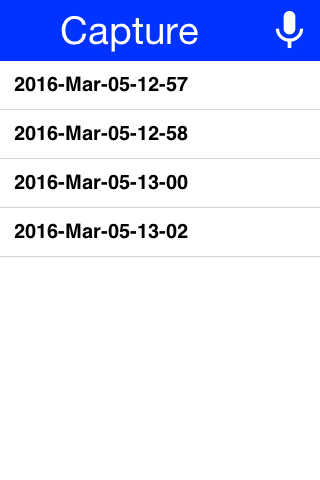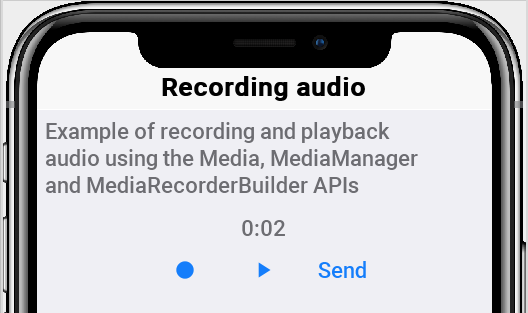
com.codename1.media.MediaManager Maven / Gradle / Ivy
/*
* Copyright (c) 2012, Codename One and/or its affiliates. All rights reserved.
* DO NOT ALTER OR REMOVE COPYRIGHT NOTICES OR THIS FILE HEADER.
* This code is free software; you can redistribute it and/or modify it
* under the terms of the GNU General Public License version 2 only, as
* published by the Free Software Foundation. Codename One designates this
* particular file as subject to the "Classpath" exception as provided
* by Oracle in the LICENSE file that accompanied this code.
*
* This code is distributed in the hope that it will be useful, but WITHOUT
* ANY WARRANTY; without even the implied warranty of MERCHANTABILITY or
* FITNESS FOR A PARTICULAR PURPOSE. See the GNU General Public License
* version 2 for more details (a copy is included in the LICENSE file that
* accompanied this code).
*
* You should have received a copy of the GNU General Public License version
* 2 along with this work; if not, write to the Free Software Foundation,
* Inc., 51 Franklin St, Fifth Floor, Boston, MA 02110-1301 USA.
*
* Please contact Codename One through http://www.codenameone.com/ if you
* need additional information or have any questions.
*/
package com.codename1.media;
import com.codename1.io.Util;
import com.codename1.ui.CN;
import com.codename1.ui.Component;
import com.codename1.ui.Display;
import com.codename1.ui.events.ActionListener;
import com.codename1.ui.util.EventDispatcher;
import com.codename1.util.AsyncResource;
import java.io.IOException;
import java.io.InputStream;
import java.io.OutputStream;
import java.util.HashMap;
import java.util.Map;
import java.util.Timer;
import java.util.TimerTask;
/**
*
* Allow us to create {@ling com.codename1.media.Media} objects using String URI's or with a stream to
* the media data.
* Notice that the underlying platforms contains the actual codecs, therefore
* you need to play common media file types such as mp3, mp4 to successfully play them across devices
* on all target platforms. The simulator can't accurately reproduce the behavior of this class in all devices/cases.
*
*
* The sample code below demonstrates simple video playback.
*
*
*
*  *
*
*
*
* The code below demonstrates capturing audio using the Capture API and playing back audio files using the Media API:
*
*
*  *
*
*
*
* The code below demonstrates capturing audio and playing back audio using the Media, MediaManager and MediaRecorderBuilder APIs,
* as alternative and more customizable approach than using the Capture API:
*
*
*  *
*/
public class MediaManager {
/**
* A static map of audio buffers. These can be used to register an Audio buffer to receive
* raw PCM data from the microphone.
* @since 7.0
*/
private static Map
*
*/
public class MediaManager {
/**
* A static map of audio buffers. These can be used to register an Audio buffer to receive
* raw PCM data from the microphone.
* @since 7.0
*/
private static Map audioBuffers = new HashMap();
private static RemoteControlListener remoteControlListener;
/**
* Gets an audio buffer at the given path.
* @param path The path to the Audio buffer. This path doesn't correspond to a real file. It is just
* used as a key to map to the audio buffer so that it can be addressed.
* @return The AudioBuffer or null if no buffer exists at that path.
* @since 7.0
*/
public static AudioBuffer getAudioBuffer(String path) {
return getAudioBuffer(path, false, 256);
}
/**
* Gets or creates an audio buffer at the given path.
* @param path The path to the Audio buffer. This path doesn't correspond to a real file. It is just
* used as a key to map to the audio buffer so that it can be addressed.
* @param create If this flag is {@literal true} and no buffer exists at the given path,
* then the buffer will be created.
* @param size The maximum size of the buffer.
* @return The audio buffer or null if no buffer exists at that path and the {@literal create} flag is {@literal false}.
* @since 7.0
*/
public static AudioBuffer getAudioBuffer(String path, boolean create, int size) {
AudioBuffer buf = null;
if (create && !audioBuffers.containsKey(path)) {
buf = new AudioBuffer(size);
audioBuffers.put(path, buf);
}
buf = audioBuffers.get(path);
buf.retain();
return buf;
}
/**
* Releases an audio buffer at a given path. Audio buffers use a simple reference counter
* mechanism. Every call to {@link #getAudioBuffer(java.lang.String, boolean, int) } will increment
* the counter, and calls to {@link #releaseAudioBuffer(java.lang.String) } will decrement the counter.
* @param path The path to the buffer.
* @since 7.0
*/
public static void releaseAudioBuffer(String path) {
AudioBuffer buf = audioBuffers.get(path);
if (buf != null) {
int refCount = buf.release();
if (refCount <= 0) {
audioBuffers.remove(path);
}
}
}
/**
* Deletes the audio buffer at the given path.
* @param path The path to the audio buffer to delete.
* @since 7.0
* @deprecated Prefer to use {@link #releaseAudioBuffer(java.lang.String) }
*/
public static void deleteAudioBuffer(String path) {
audioBuffers.remove(path);
}
/**
* Registers a listener to be notified of remote control events - e.g.
* the play/pause/seek buttons on the user's lock screen when background
* media is being played.
* @param l The remote control listener to set. null to set no listener.
* @since 7.0
*/
public static void setRemoteControlListener(RemoteControlListener l) {
boolean shouldStop = remoteControlListener != null && l == null;
if (shouldStop) {
Display.getInstance().stopRemoteControl();
}
boolean shouldStart = remoteControlListener == null && l != null;
remoteControlListener = l;
if (shouldStart) {
Display.getInstance().startRemoteControl();
}
}
/**
* Gets the currently registered remote control listener.
* @return The currently registered remote control listener, or null if
* none is registered.
* @since 7.0
*/
public static RemoteControlListener getRemoteControlListener() {
return remoteControlListener;
}
/**
* Creates an audio media that can be played in the background.
*
* @param uri the uri of the media can start with jar://, file://, http://
* (can also use rtsp:// if supported on the platform)
*
* @return Media a Media Object that can be used to control the playback
* of the media
*
* @throws IOException if creation of media from the given URI has failed
*/
public static Media createBackgroundMedia(String uri) throws IOException {
return Display.getInstance().createBackgroundMedia(uri);
}
/**
* Creates an audio media asynchronously that can be played in the background.
*
* @param uri the uri of the media can start with jar://, file://, http://
* (can also use rtsp:// if supported on the platform)
*
* @return Media a Media Object that can be used to control the playback
* of the media
*
* @since 7.0
*/
public static AsyncResource createBackgroundMediaAsync(String uri) {
return Display.getInstance().createBackgroundMediaAsync(uri);
}
/**
* Creates a Media from a given URI
*
* @param uri the uri of the media can start with file://, http:// (can also
* use rtsp:// although may not be supported on all target platforms)
* @param isVideo a boolean flag to indicate if this is a video media
* @return Media a Media Object that can be used to control the playback
* of the media
* @throws IOException if creation of media from the given URI has failed
*/
public static Media createMedia(String uri, boolean isVideo) throws IOException {
return createMedia(uri, isVideo, null);
}
/**
* Creates the Media in the given stream.
* Notice that you should invoke cleanup on a media once you are done with it.
*
* @param stream the stream containing the media data
* @param mimeType the type of the data in the stream
* @return Media a Media Object that can be used to control the playback
* of the media
* @throws java.io.IOException if the creation of the Media has failed
*/
public static Media createMedia(InputStream stream, String mimeType) throws IOException {
return createMedia(stream, mimeType, null);
}
/**
* Creates the Media in the given stream asynchronously.
* Notice that you should invoke cleanup on a media once you are done with it.
*
* @param stream the stream containing the media data
* @param mimeType the type of the data in the stream
* @return Media a Media Object that can be used to control the playback
* of the media
* @since 7.0
*/
public static AsyncResource createMediaAsync(InputStream stream, String mimeType, Runnable onCompletion) {
return Display.getInstance().createMediaAsync(stream, mimeType, onCompletion);
}
/**
* Creates a Media from a given URI
*
* @param uri the uri of the media can start with file://, http:// (can also
* use rtsp:// although may not be supported on all target platforms)
* @param isVideo a boolean flag to indicate if this is a video media
* @param onCompletion a Runnable to be called when the media has finished
* @return Media a Media Object that can be used to control the playback
* of the media
* @throws IOException if creation of media from given URI failed
*/
public static Media createMedia(String uri, boolean isVideo, Runnable onCompletion) throws IOException {
return Display.getInstance().createMedia(uri, isVideo, onCompletion);
}
/**
* Creates a Media from a given URI asynchronously.
*
* @param uri the uri of the media can start with file://, http:// (can also
* use rtsp:// although may not be supported on all target platforms)
* @param isVideo a boolean flag to indicate if this is a video media
* @param onCompletion a Runnable to be called when the media has finished
* @return Media a Media Object that can be used to control the playback
* of the media
* @since 7.0
*/
public static AsyncResource createMediaAsync(String uri, boolean isVideo, Runnable onCompletion) {
return Display.getInstance().createMediaAsync(uri, isVideo, onCompletion);
}
/**
* Adds a callback to a Media element that will be called when the media finishes playing.
*
* @param media The media to add the callback to.
* @param onCompletion The callback that will run on the EDT when the playback completes.
* @see #removeCompletionHandler(com.codename1.media.Media, java.lang.Runnable)
*/
public static void addCompletionHandler(Media media, Runnable onCompletion) {
Display.getInstance().addCompletionHandler(media, onCompletion);
}
/**
* Removes onComplete callback from Media element.
* @param media The media element.
* @param onCompletion The callback.
* @see #addCompletionHandler(com.codename1.media.Media, java.lang.Runnable)
*/
public static void removeCompletionHandler(Media media, Runnable onCompletion) {
Display.getInstance().removeCompletionHandler(media, onCompletion);
}
/**
* Creates the Media in the given stream
* Notice that you should invoke cleanup on a media once you are done with it.
*
* @param stream the stream containing the media data
* @param mimeType the type of the data in the stream
* @param onCompletion a Runnable to be called when the media has finished
* @return Media a Media Object that can be used to control the playback
* of the media
* @throws java.io.IOException if the URI access fails
*/
public static Media createMedia(InputStream stream, String mimeType, Runnable onCompletion) throws IOException {
return Display.getInstance().createMedia(stream, mimeType, onCompletion);
}
/**
* Creates a Media recorder Object which will record from the device mic to
* a file in the given path.
* The output format will be amr-nb if supported by the platform.
*
* @param path a file path to where to store the recording, if the file does
* not exists it will be created.
* @deprecated see createMediaRecorder(String path, String mimeType) instead
*/
public static Media createMediaRecorder(String path) throws IOException {
return createMediaRecorder(path, getAvailableRecordingMimeTypes()[0]);
}
/**
* Gets the recording mime type for the returned Media from the
* createMediaRecorder method
*
* @return the recording mime type
* @deprecated see getAvailableRecordingMimeTypes() instead
*/
public static String getMediaRecorderingMimeType(){
return Display.getInstance().getMediaRecorderingMimeType();
}
/**
* Gets the available recording MimeTypes
*/
public static String[] getAvailableRecordingMimeTypes(){
return Display.getInstance().getAvailableRecordingMimeTypes();
}
/**
* Creates a Media recorder Object which will record from the device mic to
* a file in the given path.
*
* @param path a file path to where to store the recording, if the file does
* not exists it will be created.
* @param mimeType the output mime type that is supported see
* getAvailableRecordingMimeTypes()
* @throws IllegalArgumentException if given mime-type is not supported
* @throws IOException id failed to create a Media object
*/
public static Media createMediaRecorder(String path, String mimeType) throws IOException {
return createMediaRecorder(new MediaRecorderBuilder().path(path).mimeType(mimeType));
}
/**
* Creates a Media recorder Object which will record from the device mic to
* a file in the given path.
*
* @param builder media settings
* @throws IllegalArgumentException if given mime-type is not supported
* @throws IOException id failed to create a Media object
* @since 7.0
*/
public static Media createMediaRecorder(MediaRecorderBuilder builder) throws IOException {
if (builder.isRedirectToAudioBuffer()) {
return builder.build();
}
String mimeType = builder.getMimeType();
if (mimeType == null && getAvailableRecordingMimeTypes().length > 0) {
mimeType = getAvailableRecordingMimeTypes()[0];
}
String path = builder.getPath();
boolean supportedMime = false;
String [] supported = getAvailableRecordingMimeTypes();
int slen = supported.length;
for (int i = 0; i < slen; i++) {
String mime = supported[i];
if(mime.equals(mimeType)){
supportedMime = true;
break;
}
}
if(!supportedMime){
throw new IllegalArgumentException("Mime type " + mimeType +
" is not supported on this platform use "
+ "getAvailableRecordingMimeTypes()");
}
return Display.getInstance().createMediaRecorder(path, mimeType);
}
/**
* Converts the media object into an AsyncMedia object. Many media objects
* area already instances of AsyncMedia, so this method would perform
* a simple cast. For media objects that are not already async, this will
* return an Async wrapper.
* @param media The media object to convert.
* @return The media object as an AsyncMedia instance.
* @since 7.0
*/
public static AsyncMedia getAsyncMedia(final Media media) {
if (media instanceof AsyncMedia) {
return (AsyncMedia)media;
}
return new AbstractMedia() {
@Override
protected void playImpl() {
State oldState = getState();
media.play();
if (media.isPlaying() && oldState != State.Playing) {
fireMediaStateChange(State.Playing);
}
if (!media.isPlaying()) {
final Timer t = new Timer();
t.schedule(new TimerTask() {
@Override
public void run() {
if (media.isPlaying()) {
t.cancel();
fireMediaStateChange(State.Playing);
}
}
}, 50, 50);
}
}
@Override
protected void pauseImpl() {
State oldState = getState();
media.pause();
if (!media.isPlaying() && oldState != State.Paused) {
fireMediaStateChange(State.Paused);
}
if (media.isPlaying()) {
final Timer t = new Timer();
t.schedule(new TimerTask() {
@Override
public void run() {
if (!media.isPlaying()) {
t.cancel();
fireMediaStateChange(State.Paused);
}
}
}, 50, 50);
}
}
@Override
public void prepare() {
media.prepare();
}
@Override
public void cleanup() {
media.cleanup();
}
@Override
public int getTime() {
return media.getTime();
}
@Override
public void setTime(int time) {
media.setTime(time);
}
@Override
public int getDuration() {
return media.getDuration();
}
@Override
public void setVolume(int vol) {
media.setVolume(vol);
}
@Override
public int getVolume() {
return media.getVolume();
}
@Override
public boolean isPlaying() {
return media.isPlaying();
}
@Override
public Component getVideoComponent() {
return media.getVideoComponent();
}
@Override
public boolean isVideo() {
return media.isVideo();
}
@Override
public boolean isFullScreen() {
return media.isFullScreen();
}
@Override
public void setFullScreen(boolean fullScreen) {
media.setFullScreen(fullScreen);
}
@Override
public void setNativePlayerMode(boolean nativePlayer) {
media.setNativePlayerMode(nativePlayer);
}
@Override
public boolean isNativePlayerMode() {
return media.isNativePlayerMode();
}
@Override
public void setVariable(String key, Object value) {
media.setVariable(key, value);
}
@Override
public Object getVariable(String key) {
return media.getVariable(key);
}
};
}
}